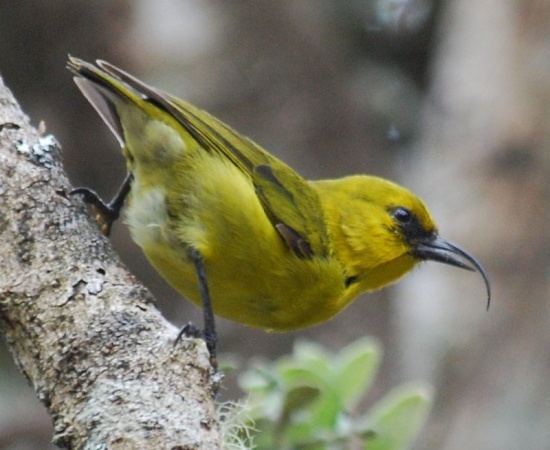- Hemignathus wilsoni
Hemignathus munroi
Identification
- Bright greenish-yellow plumage
- Black lores
- Dark bill, upper mandible extremely long and sharply curved
Distribution
Hawaii. Endemic. Currently only found above the elevation of approximately 4000 feet on the Island of Hawai'i (Big Island).
Taxonomy
The strict SM intrepretation of this bird is as Akiapolaau (Hemignathus wilsoni). The use of wilsoni in a broader genus Hemignathus was already preoccupied as a subspecific taxon name of Hawaii Amakihi, i.e., Hemignathus virens wilsoni. Therefore, the use of wilsoni as a specific taxon name was incorrect. As Hawaii Amakihi is now moved to the genus Chlorodrepanis the older name wilsoni is available again.
Habitat
Primarily inhabits native forests with numerous koa trees (Acacia koa) from 4000-7000 feet elevation, and until recently also dry forests up to 9000 feet elevation which are mostly comprised of mamane (Sophora chrysophylla), naio (Myoporum sandwicense) and pilo (Coprosma montana) trees. Usually nests in dense foliage and branches of 'ohi'a trees (Metrosideros polymorpha).
Behaviour
Adults are usually actively foraging. Typically creeps along trunks and branches of koa trees, frequently tapping or digging with its lower bill to find wood borers. When a borer is detected under the surface they will hammer with their lower bill to expose the prey, and use their long upper mandible to probe and extract borers from cavities. Strips bark and digs into exposed holes and branch ends with either mandible. Also gleans surface insects.
Breeding
They build their nests in branches of ohi'a-lehua trees.
Diet
The diet includes wood borers, grubs, caterpillars and arthropods. They utilize a woodpecker-like foraging behavior. They will also dig numerous sap wells in preferred 'ohi'a trees, and sample the sap flux of infected koa trees (dubbed "beer trees").
Vocalisation
Song is a very loud, rapid-fire warble. Calls are loud, rich, distinct and often human-like whistles of 1-4 notes. Juvenile begging beacon calls are a loud descending "tsewp". Whisper songs can be very extensive, including imitations of various other species and frequent fragments of 'akiapola'au song.
References
Audubon
External Links
GSearch checked for 2020 platform.




